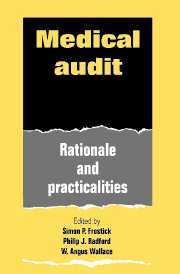Book contents
- Frontmatter
- Contents
- List of contributors
- Foreword
- Foreword
- 1 Introduction
- 2 Audit: historical and future perspectives
- 3 Audit philosophy
- 4 Medical audit: a view from the centre
- 5 Audit: a view from the Royal College of Surgeons of England
- 6 The regional viewpoint
- 7 Medical audit: the needs of the District Health Authorities
- 8 Resource management and budget holding
- 9 Unit and district information systems
- 10 Read codes and medical audit
- 11 Data capture direct from doctors
- 12 Computer systems: practice, limitations and pitfalls
- 13 Paediatric audit
- 14 Audit in obstetrics and gynaecology
- 15 Audit in general surgery
- 16 Orthopaedic audit: guidelines and hints
- 17 Installing audit in general practice and general dental practice
- 18 Clinical audit in psychiatry. Models for audit in mental health
- 19 Audit in anaesthesia
- 20 Audit in intensive care
- 21 Medical audit: lessons from the USA
- 22 Quality control in health care: the Dutch experience
- 23 Medical audit: experience from Sweden
- 24 Performance indicators
- 25 Measuring outcome and quality control
- 26 Audit: will it work?
- 27 What has been achieved so far?
- 28 A practical guide to audit
- Index
7 - Medical audit: the needs of the District Health Authorities
Published online by Cambridge University Press: 30 September 2009
- Frontmatter
- Contents
- List of contributors
- Foreword
- Foreword
- 1 Introduction
- 2 Audit: historical and future perspectives
- 3 Audit philosophy
- 4 Medical audit: a view from the centre
- 5 Audit: a view from the Royal College of Surgeons of England
- 6 The regional viewpoint
- 7 Medical audit: the needs of the District Health Authorities
- 8 Resource management and budget holding
- 9 Unit and district information systems
- 10 Read codes and medical audit
- 11 Data capture direct from doctors
- 12 Computer systems: practice, limitations and pitfalls
- 13 Paediatric audit
- 14 Audit in obstetrics and gynaecology
- 15 Audit in general surgery
- 16 Orthopaedic audit: guidelines and hints
- 17 Installing audit in general practice and general dental practice
- 18 Clinical audit in psychiatry. Models for audit in mental health
- 19 Audit in anaesthesia
- 20 Audit in intensive care
- 21 Medical audit: lessons from the USA
- 22 Quality control in health care: the Dutch experience
- 23 Medical audit: experience from Sweden
- 24 Performance indicators
- 25 Measuring outcome and quality control
- 26 Audit: will it work?
- 27 What has been achieved so far?
- 28 A practical guide to audit
- Index
Summary
Background
The publication of Working for Patients in January 1989 and subsequently Working Paper 6 on medical audit confirmed the central role that professional audit would play in the new-style NHS. The separation within the Health Service of the purchaser and provider functions is aimed at developing a more consumer-responsive approach to the delivery of health care services whilst ensuring that such services represent good value for money. In the new environment of managed competition purchasers, through their service specifications, will exert considerable influence over the practice of such providers as directly managed units (DMUs), NHS trusts and the private sector. One of the central issues in the contracting process will be balancing the range and quality of care required by purchasers with the provider unit's capacity to deliver appropriate and cost-effective services. If the standard of service delivery becomes drowned in the noise of commerce then the National Health Service is likely to suffer a serious crisis of confidence in the coming years. The contracting process therefore, needs to be steered carefully along a fine line between obtaining the best value for money in a competitive environment whilst maintaining consistent standards of medical care. Medical audit is seen as playing a key role in ensuring that this balance is maintained in the short term and consolidated in the longer term.
- Type
- Chapter
- Information
- Medical Audit , pp. 70 - 85Publisher: Cambridge University PressPrint publication year: 1993

